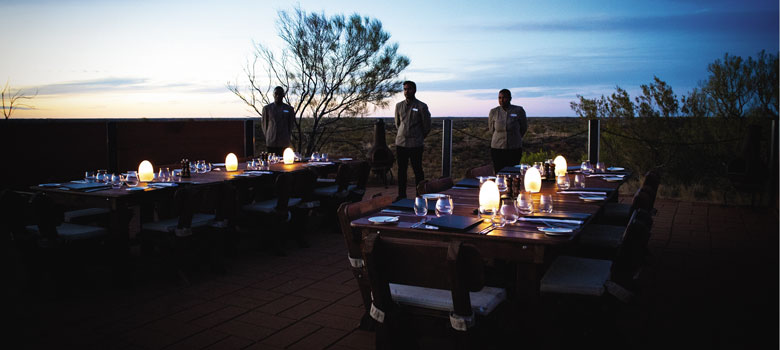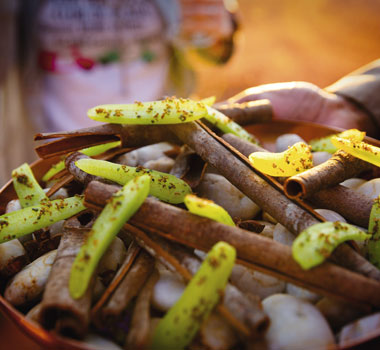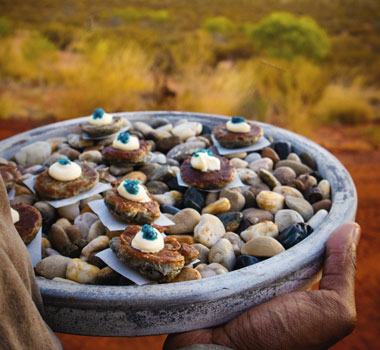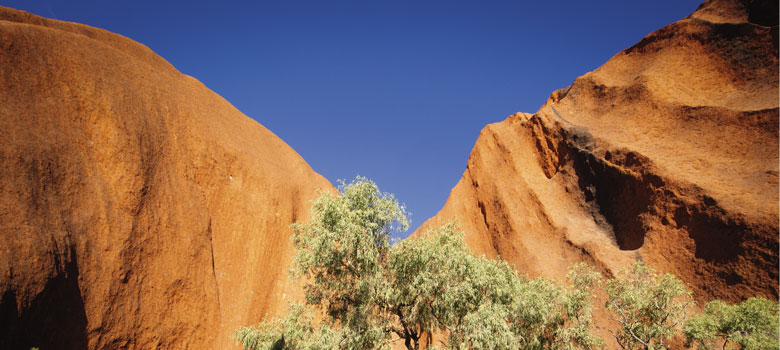
Food
Eating the NT
The sun sinks slowly behind Uluru, casting an orange halo around the topographically anomalous rock and painting the already dazzlingly red, seemingly endless soil around it an even richer burnt hue. The haunting lilts of a didgeridoo provide the soundtrack to an otherwise silent sunset as the flies, so frustratingly present throughout the day, finally leave for wherever it is flies go at night.
That’s the sense-consuming scene rolling out in front of us as we arrive at the Tali Wiru dinner, a short bus-ride from Uluru’s cluster of hotels, where native ingredients are showcased in one of the world’s greatest open-air restaurants perched atop a dune in the middle of the desert.
Australia’s first people, custodians of this arid part of the world for tens of thousands of years longer than any other culture on earth (prevailing or otherwise), have watched the sun disappear into the Uluru-spiked horizon every night for millennia, surviving on the desert’s meagre sustenance.
It was a diet that included seeds, insects and the occasional hardy fruit or vegetable, like the ‘arnguli’, a bush plum packed with vitamin C. The uncommon sight of a passing kangaroo (there’s estimated to be on average only one kangaroo for every five square kilometres in this part of the country) offered a rare opportunity for meat, provided the L-shaped boomerang used in this region flew true.
Thanks to modern conveniences like air freight and refrigeration, offerings today are far more bountiful. For the swathes of tourists that make the pilgrimage to Central Australia from around Australia and beyond every year, dining options are diverse and contemporary, far more than just fuel for the day’s exploring of Uluru and Kata Tjuta.
The exceptionally well-appointed hotels within the national park offer extravagant buffets, with the breakfast spread at Sails In The Desert’s Ilkari Restaurant even offering an omelette station spooning out a relish made from those same ancient bush plums. Come dinner, diners can tuck into a fillet of kangaroo without needing to aim a single boomerang.
Fancy a glass of bubbles with a backdrop you’ll never forget? Grab a spot at the Uluru Sunset Viewing Area, where tour bus operators set up trestle tables loaded with Sparkling wine, cheese and crackers as their passengers cheers the end of a successful sightseeing day.
Dinner on the beautiful dune

Pictured above: The Tali Wiru dinner setting.
The most memorable sunset, though, is reserved for those attending that ‘once in a lifetime’ Tali Wiru dinner (‘beautiful dune’ in the local Anangu language). The adventure begins with mouthfuls of pressed wallaby, yabbie caviar and fermented quandongs, served with Sparkling wine as Uluru slowly transforms from amber rock into black shadow, then disappears completely as the nearly-blinding ocean of stars appears.
When we finish our gin-compressed cucumber dressed with local green ants, we relocate to lantern-lit tables, where an exceptional four-course meal, highlighting still more Indigenous ingredients, is paired with an assembly of exceptional Australian wines and a laser-guided demonstration of the astrological constellations as the Aboriginal people have long understood them.
“Can you imagine a more spectacular dining room than this?” asks Karena Noble, Director of Public Relations at Voyages Resort, under whose banner Tali Wiru falls. “It’s an incredible way to enjoy not only one of the most special parts of this country, but some of its best food as well.”
After our remarkable feast, we enjoy sips of a heady bush tea as the crackling fire we’ve been sitting around is carefully doused and extinguished, leaving us alone for a few moments in the silent desert; full of food and wine, lit only by stars.
Kakadu caution


Pictured above (from left to right): The gin-compressed cucumbers ready to be enjoyed; Cuttlefish crumpets topped with clotted cream and naturally blue yabby caviar.
It’s mid-morning. Standing near the edge of a billabong, deep in Kakadu National Park in the north-east of the Northern Territory, Patsy Raglar warns me to watch for crocodiles.
Water levels are high, courtesy of the recent rainy season, creating plenty of new shallow pools in which the ancient reptiles can hide, waiting for unsuspecting prey. Like me. “They could be anywhere,” she says with unsettling casualness.
We’re 2000 kilometres north of Uluru, three hours drive from Darwin, but we might as well be in another world. The endless stretches of arid red we were surrounded by only yesterday have been replaced with plant-filled lushness, and an unrelenting but cleansing humidity.
Patsy’s family has lived on this land for tens of thousands of years. Since long before the pyramids, Stonehenge or any other ‘ancient’ remnants of human history, her ancestors existed symbiotically with Australia’s unique ecology, foraging, hunting and farming food, and taking care, in return, to preserve it.
As I continue to scan for hidden crocs, Patsy tears a sheet of paperbark from a nearby tree, careful to only remove the outer layers so as not to cause the tree any permanent harm. She pulls a few wiry blades of native grass from a dry patch of ground, and ties one to each edge of the rolled sheet of bark, creating a sturdy, watertight bowl.
Wandering ever closer to the edge of the water, she pulls on a different cluster of grasses, unearthing a bunch of thin, native yams. “This is our supermarket,” she says, as she bashes the dirt from the small potato-like vegetables on her leg, tosses them into her newly-made bowl and continues ‘shopping’ for our lunch.
The hero of our menu today is barramundi, caught this morning from the Anbangbang billabong on the banks of which we have so far avoided being eaten by crocodiles, but other regional staples feasted on by those accompanying Patsy for the day can, according to the season, include roast magpie goose, freshwater ‘mud’ mussels, wood-boring grubs, and even the occasional spot of turtle.
As part of the Kakadu ‘Animal Tracks’ Food Safari, Patsy not only provides an opportunity to sample these ‘bush foods’, cooked as they have been for centuries, but to understand the complex and respectful relationship between her people and the land they feel blessed to inhabit.
“So much of this land was ruined by colonials with sheep, cows and rabbits, then with cane toads,” says Animal Tracks operator Sean Arnold as we finish the last of the blackened barramundi and yams, leaving the all-organic scraps behind for the native whistling kites, who are already preparing their beaks in the trees around us. “Now we’re rediscovering how to eat off the land thanks to people like Patsy who are prepared to share their knowledge.”
a safe croc spot

Pictured above: One of the many beautiful views of Uluru.
It’s later, at the arrival of another spectacular Northern Territory sunset, that I’m eventually confronted with a crocodile – a gigantic specimen creating barely a ripple as it glides through the billabong – and although we’re less than five metres away as it passes, there are only gasps of excitement from our group.
We’re safe on board a Yellow Water Cruise crocodile-spotting boat, enjoying not only the spectacular bird and animal watching opportunities sunset has brought, but also a selection of canapés including, somewhat vengefully, poached crocodile.
The snack, created as the result of a careful culling exercise designed to control threateningly high crocodile numbers in the far north of the Northern Territory, emphasises the respectful relationship between food and land that has been a reoccurring theme throughout this brief, delicious visit; a crucial reminder that it’s important to protect the land, as Patsy did the paperbark, while we enjoy eating what it has to offer.
As at Tali Wiru, my day with Patsy comes to an end when the coals under which our barramundi feast was cooked are extinguished, her and her sister dutifully watching every floating ember until all fire risks are eliminated. With the birds having made quick work of our yam peels and fish bones, there’s little suggestion left that we were ever here.
Tomorrow’s sunrise will bring with it an opportunity for someone else to have their world view changed by this remarkable part of the world and, as it’s been doing for tens of thousands of years, for the land to fill not only their stomach, but their soul. Just as it has mine.